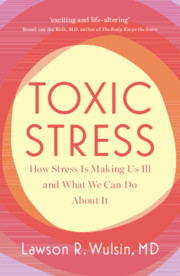Book contents
- Toxic Stress
- Reviews
- TOXIC STRESS
- Copyright page
- Contents
- Introduction: Your Body’s Hidden Symphony
- Part I The Problem
- 1 Toxic Stress – You Won’t See It Coming (Neither Will Your Doctor)
- 2 The Mind Matters for Seeing Our Blind Spot
- 3 Before We Climb This Mountain
- Part II The System
- Part III Measuring Toxic Stress
- Part IV Treatment
- Part V Our Next Frontier
- Appendix
- Acknowledgments
- Notes
- References
- Index
- About the Author
1 - Toxic Stress – You Won’t See It Coming (Neither Will Your Doctor)
from Part I - The Problem
Published online by Cambridge University Press: 18 April 2024
- Toxic Stress
- Reviews
- TOXIC STRESS
- Copyright page
- Contents
- Introduction: Your Body’s Hidden Symphony
- Part I The Problem
- 1 Toxic Stress – You Won’t See It Coming (Neither Will Your Doctor)
- 2 The Mind Matters for Seeing Our Blind Spot
- 3 Before We Climb This Mountain
- Part II The System
- Part III Measuring Toxic Stress
- Part IV Treatment
- Part V Our Next Frontier
- Appendix
- Acknowledgments
- Notes
- References
- Index
- About the Author
Summary
How big a problem is toxic stress in our own culture and around the world? Any way we measure it, toxic stress is a problem for about one in five of us. Most of us don’t know if we’re at risk for stress-related illnesses. And measurement is not easy, as Ted Daley’s experience shows us, pointing to one reason we overlook toxic stress. Teresa Langford’s story weaves throughout this book to show how toxic stress has erupted at key points in her life, suggesting lessons for the rest of us.
Keywords
- Type
- Chapter
- Information
- Toxic StressHow Stress Is Making Us Ill and What We Can Do About It, pp. 19 - 37Publisher: Cambridge University PressPrint publication year: 2024

